

February 2022 Interview with Rick Hwang, President of Rugged & Video Solutions Business Group at Getac

Getac's Mighty Class of 2021
January 2021 Interview with Rick Hwang, President of Rugged & Video Solutions Business Group at Getac

Getac V110 at Cirque du Soleil

Getac 25th Anniversary at 2014 Miramar Air Show

Getac FedEx TechConnect

TDI Panamericana 2011 team using Getac V100 on 16,000 mile endurance challenge
|

|

|
|
GETAC B360 Pro
The Pro version of Getac's 13.3-inch fully rugged laptop offers more expansion, more connectivity, more storage, and much more battery capacity.
By Conrad H. Blickenstorfer, photography by Carol Cotton)
Share on: 
 
 
 
On June 23, 2023, Getac introduced the next generation of its B360 platform which, according to the company, was the first Sub-6 5G certified line of rugged laptops. The speed, low latency, reliability and network capacity of 5G opens a range of new applications for industry, public service, field force and other key vertical market rugged computer customers. And the updated B360 promised higher performance and economy by jumping from the 10th to the 12th generation of Intel Core processors. But there was another aspect that sets Getac's B360 platform apart: it comes in a base and a "Pro" version.
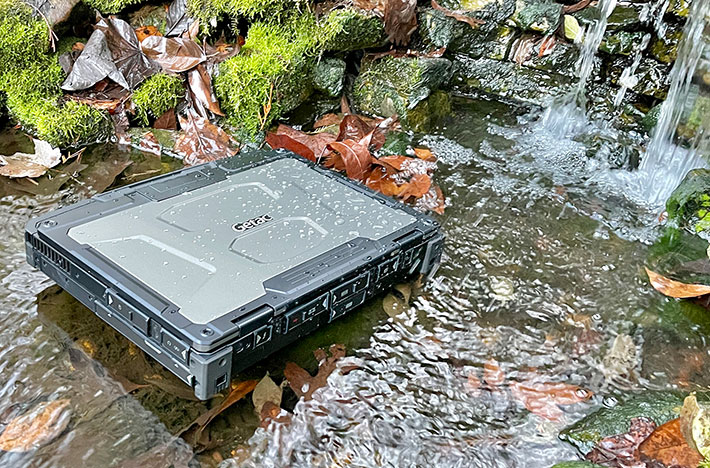
The "Pro" designation is everywhere these days. Pro is short for professional, a term commonly used to describe competent and highly trained people such as doctors, lawyers, accountants and such. We also use the word as an adjective, such as in "a professional job" or "professional quality." The short "pro" version is generally used as a sort of a superlative. There are GoPro action cameras, the iPhone Pro, ScubaPro dive gear, or golf pros. In software apps, "pro" versions have more features and cost more. So what kind of pro is the Getac B360 Pro? What are its super powers?
It's not the degree of performance that sets the base B360 and the B360 Pro apart, as they are using the same processor and storage technology. There is also, for the most part, not a great deal of difference in ports and connectivity. I say 'for the most part' because the Pro model does offer a number of potentially very relevant extras in that department. The big difference, though, is onboard battery power: The base B360 was built for low weight, low profile, and maximum mobility and doesn't have much battery. The B360 Pro does. More than FOUR TIMES as much as the base model.
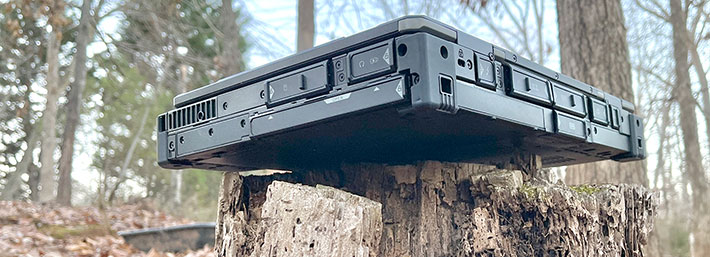
Why that large difference in battery? Because not all rugged laptops customers have the same priorities. Some want a rugged system that's as light as possible. Others want one with as much battery life as possible.
When Getac initially designed the B360 as the successor of their big, heavy, long-running B300 fully rugged laptop, due to customer feedback they made the follow-up model lighter and handier — a full inch thinner and almost three pounds lighter. That was made possible by big hard disks having been replaced by much smaller solid state disks, by the latest electronics generally much smaller than in the past, and also by using two very slim low-capacity batteries. And this allowed Getac to offer a fully rugged laptop that weighed just barely over five pounds.
But battery life can matter a great deal on the job. Out there in the field, you don't want to run out of battery and you don't want to have to baby the battery. You need to have enough to get the work done, no matter how long it takes. And that's where the B360 Pro comes in. It has two big 74.5 watt-hour batteries compared to one or two 23.3 watt-hour packs in the base B360.
|
|
Comparison between the B360 and B360 Pro
|
|
|
Model
|
B360
|
B360 Pro
|
|
|
|
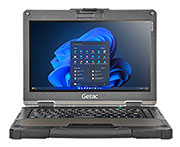
|
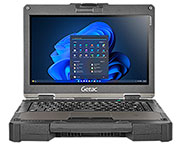
|
|
|
Introduced
|
2023
|
2023
|
|
|
OS
|
Windows 11 Pro
|
Windows 11 Pro
|
|
|
Processor
|
Intel "Alder Lake Lake" 12th gen P-Series Core
|
Intel "Alder Lake Lake" 12th gen P-Series Core
|
|
|
Cores/Threads
|
up to 6 cores and 12 threads
|
up to 6 cores and 12 threads
|
|
|
TDP-up/down
|
28/64 watts
|
28/64 watts
|
|
|
Graphics
|
Intel Iris Xe Graphics
|
Intel Iris Xe Graphics
|
|
|
Opt. Graphics
|
NA
|
NVIDIA GeForce GTX1650
|
|
|
RAM
|
8 to 64GB DDR4
|
8 to 64GB DDR4
|
|
|
Storage
|
256GB-2TB PCIe SSD
|
256GB-2TB PCIe SSD
|
|
|
Opt. 2nd Storage
|
256GB-2TB PCIe SSD PCIe SSD
|
256GB-2TB PCIe SSD PCIe SSD
|
|
|
Opt. Multimedia Bay Storage
|
NA
|
1TB or 2TB SATA SSD
|
|
|
Multimedia Bay
|
NA
|
DVD OR Blu-Ray OR 3rd storage or rd battery
|
|
|
Slots
|
Smart Card; opt. SD Card OR barcode
|
Smart Card; opt. SD Card, opt. discrete graphics OR Express Card OR PCMCIA Type II
|
|
|
SIM slots
|
Opt. Mini-SIM
|
Opt. Mini-SIM
|
|
|
Digitizer
|
Opt. capacitive
|
Opt. capacitive
|
|
|
Battery
|
46.6 watt-hour (2 x 23.3 watt-hour)
|
195.6 watt-hour (2 x 74.5 plus opt. 1 x 46.6 watt-hour)
|
|
|
Size (inches)
|
13.46 x 11.06 x 1.37
|
13.46 x 11.06 x 2.11
|
|
|
Weight (lbs.)
|
5.11
|
6.79
|
|
|
Sealing
|
IP66
|
IP66
|
|
|
Temp. range
|
-20 to 145F
|
-20 to 145F
|
|
|
Drops
|
6-feet 810H
|
6-feet 810H
|
|
|
Webcam
|
FHD with Windows Hello support
|
FHD with Windows Hello support
|
|
|
C1D2
|
optional
|
optional
|
|
|
Serial port
|
1 x DB9
|
2 x DB9
|
|
|
Extra ports
|
1 x VGA OR 2nd serial DB9
|
1 x VGA OR 3rd serial DB9
|
|
|
USB-A
|
4 x USB 3.2 Gen 2 (10 Gbps)
|
4 x USB 3.2 Gen 2 (10 Gbps)
|
|
|
USB-C
|
1 x Thunderbolt™ 4 (40 Gbps)
|
1 x Thunderbolt™ 4 (40 Gbps)
|
|
|
LAN
|
2 x 2.5GBASE-T
|
2 x 2.5GBASE-T
|
|
|
Bluetooth
|
5.2
|
5.2
|
|
|
WiFi
|
WiFi 6E AX210
|
WiFi 6E AX210
|
|
|
WWAN
|
Optional 4G LTE or 5G Sub-6
|
Optional 4G LTE or 5G Sub-6
|
Overall, what you get with this second generation of the Getac B360 Pro is a powerful and versatile laptop designed and built by one of the early pioneers in rugged laptops. The B360 Pro should have great appeal to those who used Getac B360 rugged laptops in the past but want more battery power and more expansion than the basic thin & light version of B360, and who don't mind that the Pro model is thicker and heavier.
What general size class is B360 Pro? Its 13.3-inch display is right where rugged laptop screens have been for literally decades, though, of course, the B360 uses the modern 16:9 wide format display with full HD resolution. Compared to today's super-slender consumer and business laptops, the B360 Pro is substantial. Its footprint is 13.5 x 11.1 inches, it's 2.1 inches thick and it starts at 6.8 pounds (equipped with two batteries, our test unit weighed 7.8 pounds).
The B360 Pro comes with up to 64GB of fast DDR4 RAM and up to 2 terabytes of fast PCIe NVMe solid state disk for primary storage. Optional secondary storage adds up to another 2 terabyte of SSD storage, now also of the PCIe NVMe variety (in the last gen, secondary storage still used the slower SATA interface). And if that's still not enough, customers can get up to another 2TB of SATA SSD storage in the multimedia bay.
The B360 Pro display, which is of the IPS variety as on most recent Getacs, measures 13.3 inches diagonally and has 1920 x 1080 pixel resolution, making for 166 pixels per inch, and a 16:9 aspect ratio. Its very high 1400 nits luminance (we actually measured it at 1549 nits), makes it brighter than almost anything else out there. There's, of course, 10-point capacitive multi-touch and a hard tip stylus.
As already mentioned, the B360 Pro is a substantial machine. Like the basic B360 it has two main battery bays, but each of the two batteries packs 74.5 watt-hours compared to just 23.3 watt-hours in the basic B360. And the Pro version can have an additional 46.6 watt-hour battery in its media bay, for a grand total of a massive 195.6 watt-hours.
Compared to the base B360, apart from having much more battery power, the B360 Pro's taller housing also can accommodate either an optical drive, 3rd storage or a 3rd battery on its right side, and either PCMCIA or Express Card slots, or a discrete 4GB NVIDIA GTX1650 graphics controller on the right. Depending on the intended application, the availability of discrete graphics — not available in the base version — can greatly boost graphics performance. The B360 Pro also offers four additional combination I/O port options in the back.
From the top, the B360 Pro looks exactly like the base B360. But look at it from the side and you immediately see that this is a thicker, more substantial machine. Despite the bigger package, this is still an elegant, purposeful design where form follows function. Most rugged laptops today use a black/dark silver color scheme with fine powder coating, and the B360 models are no exception. Surfaces are attractively contoured. Much of the housing is metallic. A sturdy integrated carry handle is part of the design. Below is a look at the B360 Pro from the top and from all four sides:
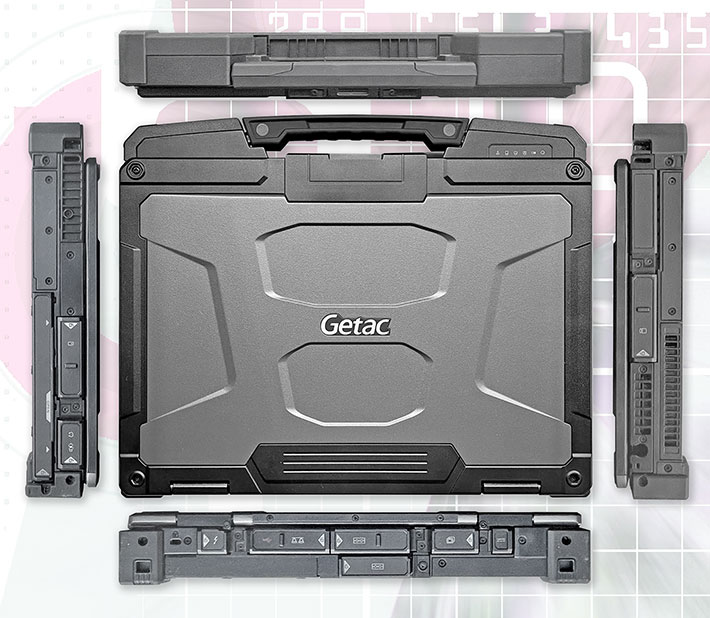
While many of the ever-slimmer (and more fragile) consumer laptops have a bare minimum of ports these days — enabled by the convenience of the small and reversible multi-purpose USB-C connector — most rugged laptops still have a full complement of standard-size ports. 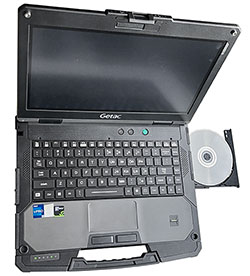 Sealing and protection of those ports is an important design consideration, one that is nowhere near as easy to implement as it sounds. Getac's solution for the B360 models are elaborate hinged plastic doors with rubber seals. The doors must be pushed into place, which can be a bit tricky. Once in place they can be snap-clicked into a locked position. You do have to be careful to get them sealed properly and snapped into place the proper way, but once you get the hang of it, it's a decent, albeit not super-obvious, solution (the new lock/unlock icon is an improvement over the last generation's). Sealing and protection of those ports is an important design consideration, one that is nowhere near as easy to implement as it sounds. Getac's solution for the B360 models are elaborate hinged plastic doors with rubber seals. The doors must be pushed into place, which can be a bit tricky. Once in place they can be snap-clicked into a locked position. You do have to be careful to get them sealed properly and snapped into place the proper way, but once you get the hang of it, it's a decent, albeit not super-obvious, solution (the new lock/unlock icon is an improvement over the last generation's).
To the right is a look at the B360 Pro's optical drive option (either DVD or Blu-Ray super-multi). Optical disks, of course, have largely been replaced by USB drives, but there are still occasions where one is needed.
Below is a look at the backside of the B360 Pro, with all of its protective doors removed (each is bolted on with two small Philips screws).
On top, from left to right, there's a Kensington lock slot, a Thunderbolt™ 4 port using the USB-C plug, a USB 3.2 gen 2 ports, an RJ45 connector, an HDMI 2.0 port, two areas for optional and configurable I/O (our unit came with just a DB9 legacy serial port), a DisplayPort connector (could also be another DB9 legacy serial port or a VGA port), and finally the power jack. This is the exact same layout as on the base B360. On the bottom is just one more port, another optional RS232 serial port.

Below are the two side views of the B360 Pro, again with all protective doors removed. On top is the left side view with, from left to right, the tether anchor hole for the stylus, the stylus slot, the fan/heat exchanger grille, primary and secondary mass storage, and smart card reader.
On the bottom is the right sideview. Here we see, from left to right, the area for an optional barcode scanner (which our tester didn't have), optional SIM and SD card reader slots, 3.5mm audio jack, and a PowerShare USB 3.2 Type-A port. Here, again, the port layouts are the same as on the base B360.
Below the ports area, you can see the media bay which in our review unit housed an optional optical drive. Alternately, this area can be used for an additional solid state storage drive or a third battery that would add another 46.6 watt-hours of capacity.
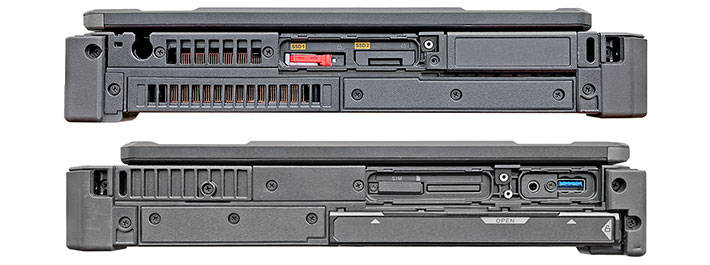
Overall, what are the changes here from the last generation of the B360 Pro to the second generation one? In the back there's now the Thunderbolt™ 4 port and the Type-A port is now of the faster USB 3.2 Gen 2 variety. On the left side, the secondary solid state storage drive is now using the fast PCIe NVMe interface as well. And on the right side, the PowerShare USB Type A port is now USB 3.2 instead of the old 2.0. This translates into overall faster communication and data transfer.
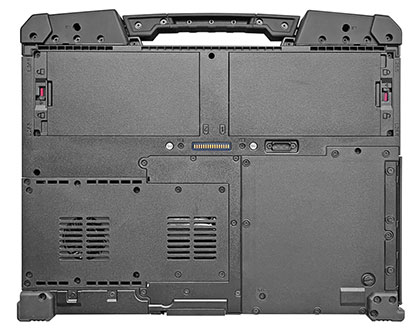 Note that Getac offers a good number of customization options. The I/O area in the back, for example, can be equipped with various I/O combos, such as: Note that Getac offers a good number of customization options. The I/O area in the back, for example, can be equipped with various I/O combos, such as:
- 1 x Serial + VGA
- 1 x Serial + DisplayPort
- 1 x Serial + VGA + 2nd LAN (RJ45)
- 1 x Serial + DisplayPort + 2nd LAN (RJ45)
- 2 x Serial + VGA
- 2 x Serial + DisplayPort
- 2 x Serial + VGA + 2nd LAN (RJ45)
- 2 x Serial + DisplayPort + 2nd LAN (RJ45)
In addition, the B360 Pro can be equipped with optional fingerprint scanner or an HF RFID reader.
The bottom of the B360 Pro is mostly unadorned. The two big main batteries fit flush into the body of the laptop. A springloaded lockable mechanism keeps them securely in place, but also makes them replaceable within seconds.
In the center of the bottom is the surface-mount docking connector for the B360 Pro's optional office and vehicles docks. Next to that appear to be antenna pass-throughs. Unlike many laptops, the B360 Pro doesn't have an access door to RAM or expansion card slots.
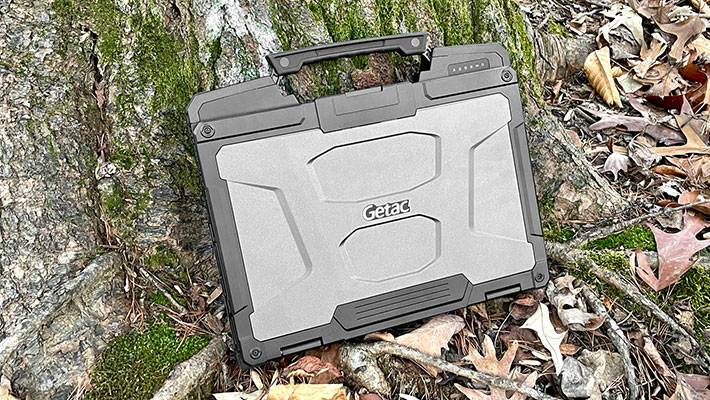
Thoughtful design
Designing a laptop is like designing a car. Inside is what makes the car and the laptop go. Around that is the structure and packaging, and outside an attractive, functional shape. A laptop is a box with a keyboard in it and a hinged screen that's like the cover of the box. Form follows function to the extreme.
Coming up with an elegant, attractive laptop design that communicates toughness, competence, professionalism, and a unique brand identity isn't easy. But Getac has decades of experience with that and the B360 Pro is a very good-looking piece of equipment. Colors, materials, textures, lines, corners, labels, everything looks, works, and fits just right.
The attention to detail on this laptop is more than impressive. Yes, form follows function, but form also contributes to ergonomics, ease-of-use, and also eye-pleasing visual design. Just like the big Getac X600 and X600 Pro rugged workstations we reviewed a few months ago, the Getac B360 Pro is a convincing design.
And that includes the details. The mustachioed German philosopher Friedrich Nietzsche once observed that that's where the devil is, in the details. In all the small little things that often get overlooked, and that, if not properly designed and attended to, will come back to haunt you.
A laptop has lots of details, and Getac quite obviously thought them through. Below are some of the details that showcase this impressive attention to every detail:
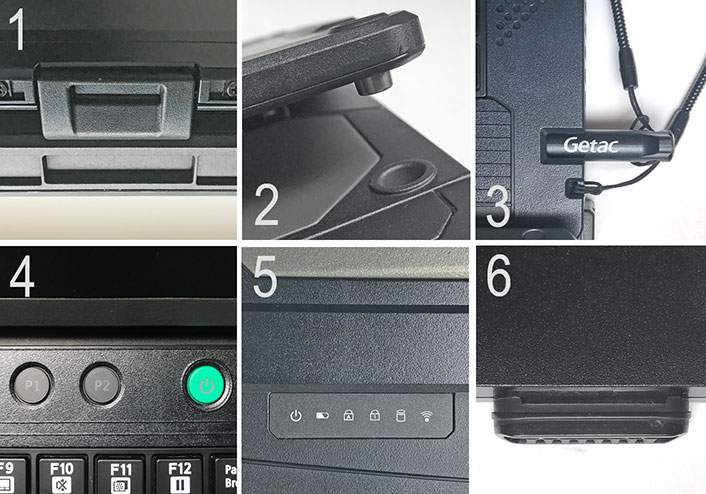
Clockwise and starting from the upper left, you can see:
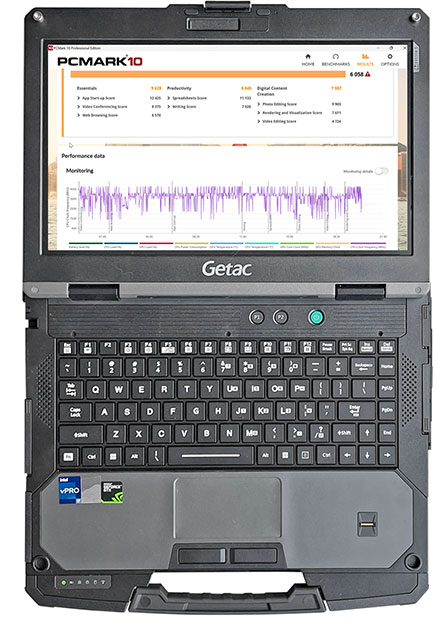 - The clasp that secures the LCD screen against the computer case with the keyboard is one of the most important parts of every laptop. You don't want for the screen to open up when it shouldn't, and you don't want a clasp/lock that's clumsy and hard to operate. Getac got it just right with a spring-loaded clasp that automatically locks, but also easily lets go with just a tap on the clasp.
- If a rugged computer gets dropped (and it will), the screen must not be jarred open upon impact. Two steel bolts make sure that would never happen in the B360 Pro.
- If you use a stylus with your laptop, it should be tethered and it should have a stylus garage in a convenient and easily located spot. The B360 Pro has that. And it says "Getac" on it. Most of us have many styli. To know which one goes with which device is a very good idea.
- Too many buttons are confusing, especially if they are poorly labeled. Getac gave the B360 platform just three, a good number. They are backlit and clearly labeled. A green power button and two programmable function buttons. Excellent.
- Annunciator lights tell the user what the computer is doing. All too often such lights are poorly labeled and in hard-to-see places. On the B360 Pro they are clearly labeled and where you can easily see them, as it should be.
- The Getac B360 Pro's hot-swappable batteries are flush-mounted into the bottom of the computer case. It'd require a big seal to keep the entire battery compartment dry. So Getac used just an O-ring seal around the battery connector. A common solution, but especially well implemented here.
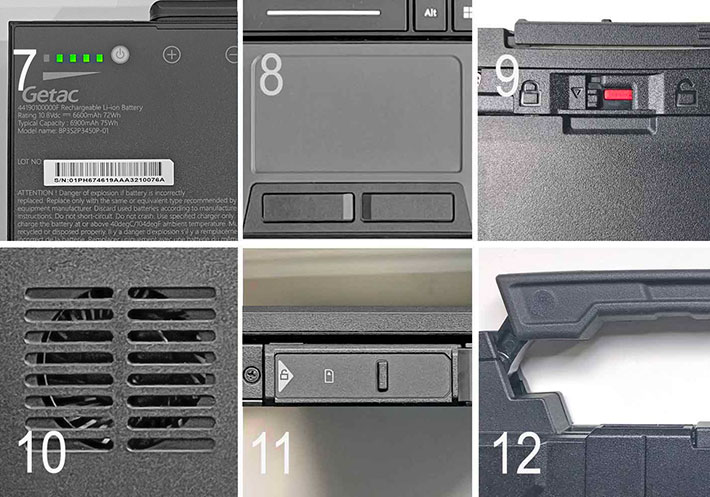
And another set of nice details: clockwise and starting from the upper left, you can see:
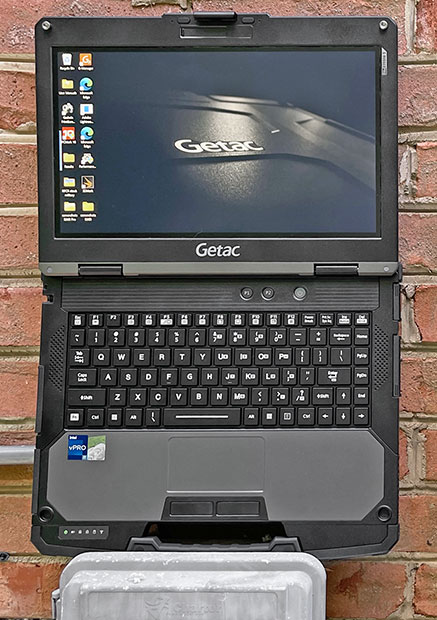 - It's great to have hot-swappable batteries, but do you always know if your spares are actually charged? And how much? With the B360 Pro's batteries there's never any doubt; just push a button and five LEDs show the charge level.
- Many touch pads are too deeply recessed for convenient use. The B360 Pro's 3-1/2 x 2 inch capacitive multi-touch pad is recessed only as much so you can easily sense its perimeter with your finger(s). It's also very responsive and has the exact right surface stiction.
- You want to be able to replace hot-swappable batteries quickly and easily, but you don't want to have them come loose or fall out by mistake. The B360 Pro has lockable spring-loaded levers that work just right.
- The B360 Pro has a small fan and a fan grille. Have no fear, though: the fan's housing is completely sealed to the interior of the laptop, and the fan itself works even underwater.
- This is the port sealing method Getac uses on the B360 Pro. Sealing external standard ports is never easy, designing such ports isn't easy, and making sure they are properly secured requires a conscious effort. It takes a bit of getting used to the ports on the B360 line, but they get the job done.
- Hard carry handles are almost a must on a rugged laptop, but many are bulky and not all are convenient to use. We like the B360 Pro's design where the handle is nicely integrated but then clicks into a carrying position when you need it.
Per Getac's request we did not dismantle the B360 Pro to get an idea what it looks like inside, how easy or difficult it is to disassemble and reassemble the unit, and get an idea of the type of thermal management system. We did, however, use our FLIR One IR thermal imaging camera to see heat flows and heat dissipation. The images below show the B360 Pro's thermal signature while it was running the demanding PCMark10 benchmark. Temperatures are a bit higher overall than in the prior generation B360 Pro, as is to be expected with the more powerful new processors. Still, with the cooling fan going during high-load processing, we didn't see more than 107F anywhere.

Keyboard and hardware controls
A good, high-quality keyboard is essential in a laptop for the field. If it isn't good — perfect — one might as well use a tablet. Getac has used a variety of keyboard technologies in its rugged and semi-rugged notebooks over the years. Initially Getac laptops used older-style beveled keys. Over time, keyboards became more water-resistant and used mechanical membrane technology. The B360 Pro likewise uses an LED backlit membrane keyboard, with an optional LED backlit rubber keyboard also available.
These days almost all keyboards use the "island-style" design and look with short key travel but noticeable tactile feedback. That's important in the field; everything must be optimized for functionality, clarity and ease of use. The thick type and white-on-black icons make the B360 kPro keyboard look a bit busy and cluttered. Function labels are icon-style black on white, sometimes below and sometimes to the right of the default character of the key. The whole design looks and feels much like the standard Apple keyboard, which today is as much praised for its "look and feel" as the original IBM PC keyboard was at the dawn of personal computing.
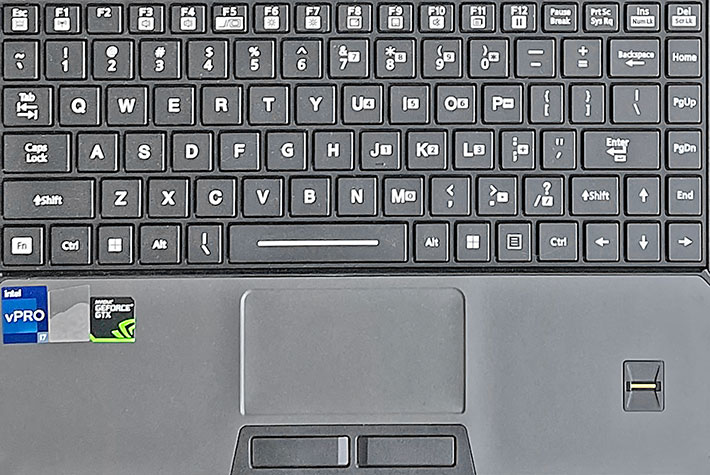
Placement of the keyboard in relation to the slightly recessed capacitive multi-touch touchpad and the two "mouse" buttons is just right. The touchpad itself is a bit larger in the prior version. And, almost needless to say for full-size laptop, the all-important QWERTY layout is 100%-scale. That means the distance between the center of the letter Q and the center of the letter P is exactly 6-3/4 inches. 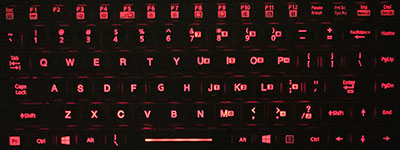 This way, anyone used to a standard keyboard will have no problem finding the key and feeling at home, even if they are not full touch typists. This way, anyone used to a standard keyboard will have no problem finding the key and feeling at home, even if they are not full touch typists.
The LED-based backlight can be toggled on/off via a function key combination. Illumination is reddish-tinted white, and it clearly illuminates the keys in semi and full darkness.
Unlike some earlier Getac rugged laptops we reviewed, illumination doesn't bleed out much around the keys in the dark. That makes the layout easier to read in the dark.
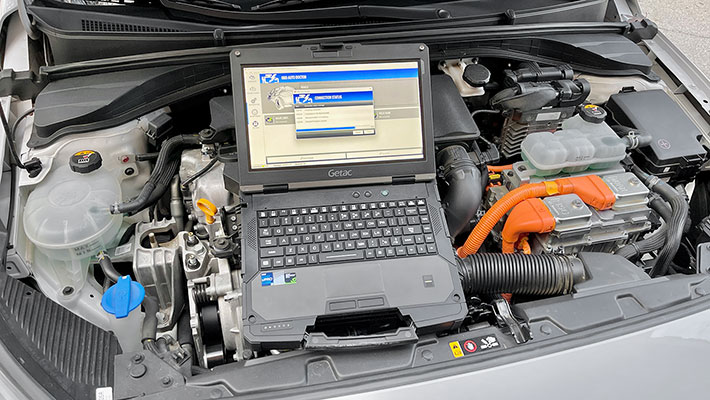
Powered by Intel 12th generation "Alder Lake" Core processor technology
The second generation of Getac's B360 platform is powered by Intel "Alder Lake" 12th generation Core processors. That's a two-generation jump up from the Intel 10th gen "Comet Lake" chips in the original B360 platform. Even just a few months after the introduction of the new machines, there's already the "Raptor Lake" 13th generation of Core processors (Raptor Lake is in Getac's latest S410 semi-rugged laptops that were launched a few months after the latest gen of the B360). It must be a little frustrating for manufacturers of rugged laptops — which generally have a longer life cycle than consumer versions — to quickly fall behind in processor technology due to Intel's rapid-fire succession of chip generations. Because, truth be told, with rare exceptions, the difference between processor generations isn't that big.
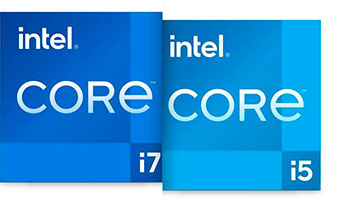
More often than not, one of the faster chip options of a prior generation is likely to still be quicker than one of the lower-end options of the next generation or even the one after. As stated, there are exceptions. One was when quad-core processors became available for the first time. That made a big difference. Another was the "Tiger Lake" 11th generation that brought manufacturer-side dynamic tuning, Thunderbolt™ 4 support, Iris Xe, and was just generally a great design.
Is the "Alder Lake" 12th generation one of those exceptional ones? Hard to say. It is different, because it is Intel's first mainstream "hybrid" architecture. What does hybrid mean in this context? It means that "Alder Lake" chips have two different kinds of processing cores. There are complex, powerful P-cores (power cores) and smaller, less complex E-cores (efficient cores). The idea behind this is that the P-cores, which draw a lot of power, do the heavy lifting, whereas the economical E-cores do all the less-demanding routine everyday tasks. That's the way the ARM-based processors used in virtually all smartphones have been doing it for many years: power cores for maximum performance, and economy cores to save battery life — packing the best of both worlds into one chip.
But who makes the decision of what ought to run where and when? That task falls to a scheduler program designed to make sure everything runs as quickly as possible AND as economically as possible. For that to happen, Intel and Microsoft worked together on a hardware/software approach. On the hardware side, Intel Alder Lake chips have a special embedded controller — a Thread Director — that keeps track of all the metrics and passes on that information to the operating system scheduler program that then uses all that information to make intelligent decisions. This teamwork between hardware and software, however, requires Windows 11. Alder Lake chips can, of course, run Windows 10, but to take full advantage of Intel's new hybrid technology, you need Windows 11. To read our interpretation of all of this, see Intel's 12th generation "Alder Lake" Hybrid processors.
The B360 Pro comes by default with an Intel Core i5-1240P, but Getac also offers four higher level chip options. The table below shows all five of them:
|
CPU
|
Intel Core i7
|
Intel Core i7
|
Intel Core i7
|
Intel Core i5
|
Intel Core i5
|
|
Model
|
1280P
|
1270P
|
1260P
|
1250P
|
1240P
|
|
P-Cores/Threads
|
6/12
|
4/8
|
4/8
|
4/8
|
4/8
|
|
E-Cores
|
8
|
8
|
8
|
8
|
8
|
|
Total Threads
|
20
|
16
|
16
|
16
|
16
|
|
P-cores Max Turbo
|
4.80 GHz
|
4.80 GHz
|
4.70 GHz
|
4.40 GHz
|
4.40 GHz
|
|
P-cores Max Turbo
|
3.60 GHz
|
3.50 GHz
|
3.40 GHz
|
3.30 GHz
|
3.30 GHz
|
|
Thermal Design Power (TDP)
|
28/64 watts
|
28/64 watts
|
28/64 watts
|
28/64 watts
|
28/64 watts
|
|
Smart Cache
|
24MB
|
18MB
|
18MB
|
12MB
|
12MB
|
|
Integrated graphics
|
Iris Xe Graphics
|
Iris Xe Graphics
|
Iris Xe Graphics
|
Iris Xe Graphics
|
Iris Xe Graphics
|
|
Execution Units
|
96
|
96
|
96
|
80
|
80
|
|
Graphics max speed
|
1.45 GHz
|
1.40 GHz
|
1.40 GHz
|
1.40 GHz
|
1.30 GHz
|
|
Relative CPU cost
|
482
|
438
|
480
|
320
|
353
|
Looking at the table, you'll see right away that Alder Lake's hybrid technology means a lot more computing cores. All five options have eight efficiency cores. On top of that, there are four power cores in four of the five options, and six in the top-end chip. Each of the power cores has two threads. So these new chips have 12 to 14 cores and 16 to 20 threads!
And the different kinds and numbers of cores is not the only thing that has changed. The two types of cores have different default and top frequencies. And whereas the 10th generation processors in the original B360 were all rated as having a Thermal Design Power (TDP) of 15 watts, the 12th generation chips are all listed as having 28 watts "base power" and 64 watts "max turbo power." What is TDP in the first place? It's a somewhat vague Intel measure of how much heat a tablet or laptop must be able to dissipate for a certain processor. So a jump from 15 watts to 64 watts is quite large. And it is also large compared to Intel's 12/28 watts designation for "Tiger Lake" 11th generation processors.
So we're a little bit in uncharted water here, what with Intel's changing classifications and specifications. As is, Getac chose "P-Series" processors for the second gen of the B360 platform. Intel designates those for "thin and light laptops," but we can see them as the perfect choice for machines like the heavier B360 Pro. However, for years rugged laptops and tablets have been using "U-Series" processors, and that also goes for other rugged systems that switched to Alder Lake. So it's not entirely clear if "P" is the new "U" in premium rugged systems, or if the choice signals Getac's return to using high-powered CPUs even at the cost of higher power draw, as the company has in the past?
In order to get a sense of where the Getac B360 Pro stands in terms of raw performance compared to its primary fully-rugged laptop competition, we ran our standard benchmark suites (PassMark 6.1 and 9, CrystalMark, PCMark10, 3DMark, and GeekBench 5). The results are as follows:
|
Getac B360 Pro G2 in context
|
|
PERFORMANCE COMPARISON
|
Getac
|
Getac
|
Dell
|
Durabook
|
Panasonic
|
|
Model
|
B360 Pro G2
|
B360 Pro G1
|
Latitude 7330
|
DURABOOK Z14I
|
TOUGHBOOK 40
|
|
Year tested
|
2023
|
2021
|
2022
|
2021
|
2024
|
|
Processor
|
Intel Core
|
Intel Core
|
Intel Core
|
Intel Core
|
Intel Core
|
|
Processor Model
|
i7-1280P (G12)
|
i7-10710U (G10)
|
i7-1185G7 (G11)
|
i7-1165G7 (G11)
|
i7-1185G7 (G11)
|
|
Code name
|
Alder Lake
|
Comet Lake
|
Tiger Lake
|
Tiger Lake
|
Tiger Lake
|
|
Thermal Design Power (TDP)
|
28/64 watts
|
15 watts
|
12/28 watts
|
12/28 watts
|
12/28 watts
|
|
CPU Clock
|
1.60GHz
|
1.10GHz
|
1.90GHz
|
1.60GHz
|
1.60GHz
|
|
CPU Turbo
|
4.20GHz
|
4.70GHz
|
4.20GHz
|
3.40GHz
|
4.10GHz
|
|
CPU Cores/Threads
|
14/20
|
6/12
|
4/8
|
4/8
|
4/8
|
|
Graphics
|
Intel Iris Xe
|
Intel UHD
|
Intel Iris Xe
|
Intel Iris Xe
|
Intel Iris Xe
|
|
Discrete Graphics
|
GTX 1650
|
GTX 1050
|
No
|
No
|
No
|
|
Display
|
13.3-inch 1920x1080
|
13.3-inch 1920x1080
|
13.3-inch 1920x1080
|
14.0-inch 1920x1080
|
14.0-inch 1920x1080
|
|
Display Luminance
|
1640 nits
|
1555 nits
|
1348 nits
|
1150 nits
|
1235 nits
|
|
Cooling
|
Active (fan)
|
Active (fan)
|
Active (fan)
|
Passive
|
Active (fan)
|
|
Weight
|
7.80 lbs as tested
|
NA lbs as tested
|
6.00 lbs as tested
|
8.75 lbs as tested
|
7.87 lbs as tested
|
|
Minimum Power Draw
|
4.2 watts
|
2.2 watts
|
3.2 watts
|
6.1 watts
|
5.6 watts
|
|
PassMark 9.0
|
6,299
|
4,531
|
6,030
|
4,800
|
4,631
|
|
CrystalMark
|
549,591
|
333,057
|
521,004
|
463,662
|
435,530
|
|
PCMark10 Overall
|
5,490
|
4,265
|
5,231
|
4,623
|
4,835
|
|
-- PCMark10 Essentials
|
8,683
|
9,923
|
10,253
|
9,472
|
9.177
|
|
-- PCMark10 Productivity
|
7,282
|
7,356
|
6,896
|
6,441
|
6,519
|
|
-- PCMark10 Content Creation
|
7,102
|
3,070
|
5,498
|
4,395
|
5,128
|
|
PCMark10 Drive
|
1,430
|
1,825
|
1,818
|
1,232
|
1,248
|
|
PCMark10 Battery
|
16:42 hrs (149 whr)
|
NA
|
15:22 hrs (105 whr)
|
9:41 hrs (84.2 whr)
|
5:55 hrs (68 whr)
|
|
PCMark10 Battery
|
0.148 whr/min
|
NA
|
0.114 whr/min
|
0.145 whr/min
|
0.192 whr/min
|
|
3DMark Time Spy
|
3,510
|
1,520
|
1,818
|
1,232
|
1,163
|
|
GeekBench 5 Single Core
|
1,635
|
1,238
|
1,560
|
1,391
|
1,358
|
|
GeekBench 5 Multi Core
|
8,314
|
4,187
|
5,779
|
3,640
|
3,815
|
|
GeekBench 5 Open CL
|
39,424
|
NA
|
17,533
|
12,168
|
12,419
|
What do the benchmarks show? Some of the results are obvious and expected, others less so.
First, the B360 Pro is a very powerful machine, outperforming the original B360 Pro we tested in almost all benchmarks. That said, the overall margin of extra performance wasn't quite as much as we had expected from P-Series chip. Why might that be? The most likely reason is that the still new hybrid architecture hasn't matured yet to a point where the OS and software can take full advantage of the powerful hardware with all of its processors. So it's quite possible that Windows 11 updates, especially on the thread director, will unlock additional performance over time.
We're usually showing a broader range of competitors in the comparison tables, but when it comes to fully rugged premium laptops, these four are likely what most customers will consider.
If you're interested in the performance of the discrete graphics option installed in our review B360 Pro, below are its 3DMARK results, compared to the results of our base B360 tester that came without discrete graphics. Both units had the exact same CPU and memory configuration. If graphics performance matters, the available NVIDIA GTX 1650 option, only available for the Pro version, adds a good deal of extra punch.

Very long battery life
Just as is the case with electric vehicles, balancing range with battery size, weight and cost is a never-ending challenge for designers of rugged computing gear. Back when rugged laptops were heavy and bulky, there was room for a big battery, and customers didn't mind the weight so much.  But that has changed. Unlike the base Getac B360 with its emphasis on being as thin & light a design as a fully rugged laptop can be, which required some battery capacity concessions, the B360 Pro has no such problem. Its extra 3/4 inch of height provides room for much larger batteries. But that has changed. Unlike the base Getac B360 with its emphasis on being as thin & light a design as a fully rugged laptop can be, which required some battery capacity concessions, the B360 Pro has no such problem. Its extra 3/4 inch of height provides room for much larger batteries.
Battery technology, overall, has come a long way since the early days of rugged laptops. Back then, they needed a big 90 or 100 watt-hour battery to last just two or three hours.
Today's electronics are far more power-efficient. Even the base B360 with its two small, slender batteries with a combined 46.6 watt-hours, ran 4-1/2 hours in our demanding PCMark 10 battery test. So what kind of battery life can one expect from the B360 Pro with the 149 watt-hours of its two standard batteries? Getac specs don't list expected battery life in the B360 Pro's specs, probably because battery life depends on so many variables. So, given the B360's substantial performance and super-bright screen, what will we find?
|
Getac B360 Pro BatteryMon Power Draws (at idle)
|
|
|
Backlight level
|
Darkest
|
50%
|
Brightest
|
|
|
Max Battery
|
4.2 watts (35.5 hrs.)
|
5.6 watts (26.6 hrs.)
|
11.0 watts (13.5 hrs.)
|
|
|
Max Performance
|
5.3 watts (28.1 hrs.)
|
6.2 watts (24.0 hrs.)
|
12.1 watts (12.3 hrs.)
|
We used PassMark's BatteryMon to measure basic power draw. Selecting the Getac "Best Power Efficiency" mode, and screen brightness toggle set to its lowest setting, we saw a minimum of 4.2 watts, not bad, but a lot more than the original B360 Pro's minimum draw of just 2.2 watts. With the backlight set to 50% it was 5.6 watts (compared to the old machine's 2.8 watts), and with the backlight at 100%, 11.0 watts — more than the predecessor's 7.7 watts but really not much given the very bright screen. Dividing the full available 149 watt-hours by the lowest observed power draw of 4.2 watts would indicate a theoretical battery life of a stellar 35.4 hours.
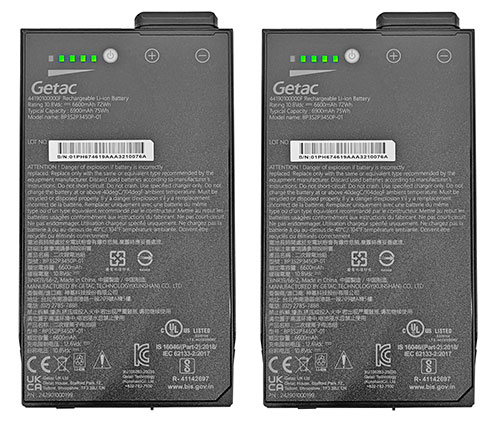 Putting the B360 Pro into Windows' "Best Performance" power mode and toggling the backlight to 0%, power draw was 5.3 watts, good for a theoretical 28.1 hours. With the backlight set to the 50% level, it was 6.2 watts, still good for 24.0 hours. Putting the B360 Pro into Windows' "Best Performance" power mode and toggling the backlight to 0%, power draw was 5.3 watts, good for a theoretical 28.1 hours. With the backlight set to the 50% level, it was 6.2 watts, still good for 24.0 hours.
With the backlight at 100%, power draw rose to 12.1 watts. This means that even in "Best Performance" mode and the strong backlight as bright as Windows sets it, theoretical battery life is still 12.1 hours.
Getting 12 hours of run time out of the two B360 Pro's two standard batteries even with the backlight full bright would allow constant outdoors operation for well over a full shift. And the batteries are hot-swappable, carrying a spare or two means that battery life is pretty much a non-issue with this machine. But if that's still not enough, there's the optional media bay battery that adds another 46.6 watt-hours.
All that said, the power draw that BatteryMon measure is with the computer just idling along. In real life use, computers go into standby mode after a period of idling, using even less power, but when called to do actual work, they use much more. Which mean that real life battery life will vary. And, in fact, when we ran the PCMark10 Battery benchmark, which continuously exercises the computer until the battery is exhausted, we saw just 16:42 hours. So, given the second gen B360 Pro's powerful processor with all its cores and higher power draw, this rugged laptop elimninates "range anxiety."
Ruggedness
Despite being heavier than the thinner and lighter base version of the B360, the B360 Pro also is a fully rugged machine and designed to reliably perform under extreme working environments where weather conditions and physical abuse are an ever-present reality. The machine can operate between -20° and 145° Fahrenheit (-29° to 63°C). Sealing is at the IP66 standard, and the machine fills MIL-STD-810H testing requirements for humidity, altitude, shock, drop, vibration and others, and the B360 Pro is also compliant with MIL-STD-461G (electromagnetic interference). The pictures below show samples of the kind of ruggedness testing Getac performs on all of their computers.
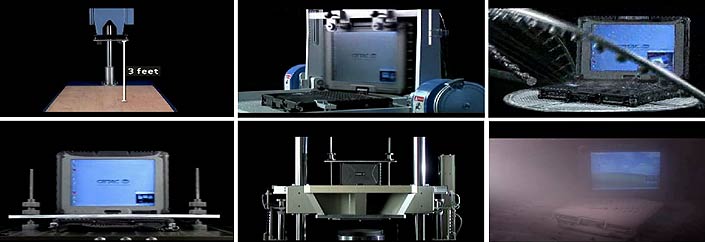
To go into a bit more detail on the individual ruggedness testing categories:
IP ratings refer to Ingress Protection standards for electrical enclosures, with the first number describing the protection level against solids and the second protection against liquids. The B360 Pro's IP66 rating indicates total protection against dust, and the laptop is also protected against strong jets of water from all directions. That is far above semi-rugged laptops' IP52 or IP53 ingress protection ratings.
 In terms of temperature resistance, the B360 Pro's extremely wide -20 to 145 degrees Fahrenheit operating temperature range was measured in accordance with MIL-STD-810H, 501.5 Procedure II and 502.5 Procedure II. The computer also passed non-condensing humidity testing up to 95% per MIL-STD-810H, 507.5 Procedure II, and can operate in altitudes up to 15,000 feet (and obviously in aircraft with pressurized cabins) per MIL-STD-810H, 500.5 Procedure II. In terms of temperature resistance, the B360 Pro's extremely wide -20 to 145 degrees Fahrenheit operating temperature range was measured in accordance with MIL-STD-810H, 501.5 Procedure II and 502.5 Procedure II. The computer also passed non-condensing humidity testing up to 95% per MIL-STD-810H, 507.5 Procedure II, and can operate in altitudes up to 15,000 feet (and obviously in aircraft with pressurized cabins) per MIL-STD-810H, 500.5 Procedure II.
The device is RoHS-compliant. RoHS stands for Restriction of Hazardous Substances and regulates the use of certain hazardous substances in electronic equipment. The RoHS standard is fully implemented in Europe, with lesser restrictions applying in the US.
Shock, vibration, drop and ESD resistance are all tested according to MIL-STD-810H and other relevant regulatory procedures. Not all results are in the promotional literature or owner's manual (which for now only states "vibration & 6ft (1.8m) drop resistant"), so inquire with Getac for specifics and also check Getac's certification and compliance testing document (see here).
With respect to the drop spec, rugged laptops are generally expected to pass 26 drops from four feet. Why four feet? Because when designing the drop tests, the government figured that if you drop something while standing, it'll drop about four feet, as opposed to something that falls off a table or counter, which is 2.5 to three feet. So if the Getac B360 Pro is 6-foot drop resistant, that is very impressive.
I should mention that optionally available is ANSI/UL 121201, CSA C22.2 NO. 213 certification as electrical equipment for use in Class I, Division 2 hazardous locations (i.e. places where ignitable concentrations of flammable gases, vapors or liquids may happen). There are multiple configuration options to fit desired usage scenarios in potentially explosive environments typically found in the oil and gas, petrochemical, aviation and related industries.
Finally, Getac's rugged mobile computer decontamination document (see here) recommends a number of commonly available disinfectants for the B360 platform. Those have all been tested for 10,000 swipe-downs at a pressure of 14.22 psi.
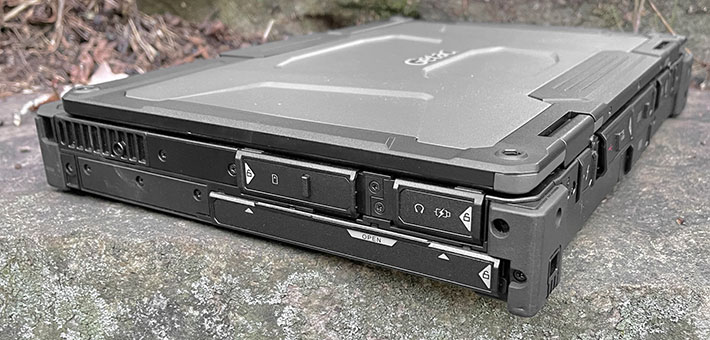
LumiBond® 2 display works well indoors and out
Computer displays have come a very long way since the early days of the PC, with many of today's displays being pretty much perfect. Indoors, that is. Outdoors, the sun can overwhelm the brightest display, and there are reflections that can make a screen difficult to see and use. Clearly, outdoor/sunlight viewability is of crucial importance to users of rugged laptops such as the Getac B360 Pro.
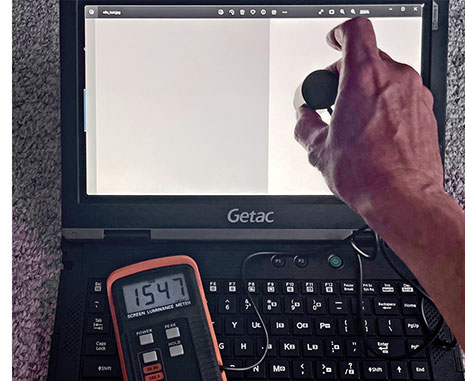 As a result, rugged computer manufacturers have long been in a race for the best possible outdoor/sunlight-viewable display technology. As a result, rugged computer manufacturers have long been in a race for the best possible outdoor/sunlight-viewable display technology.
Several years ago, Getac came up with their "QuadraClear®" (see QuadraClear® page) display technology. The term refers to its four core features: a bright backlight, anti-reflective coatings, linear polarizer, and circular polarizer.
All major manufacturers of outdoor-usable mobile computing equipment use those technologies, and so the difference boils down to a) backlight brightness and b) the extent to which the expensive optical coatings are applied and how the various layers are bonded (the fewer reflective surfaces, the better). Getac calls their layer bonding process "LumiBond®" (see LumiBond® page).
What constitutes a "powerful" backlight? That's where luminance, the intensity of light emitted, comes in.
Luminance is measured in candela per square meter, where candela refers to luminous intensity, the power emitted by a light source. Since "candela per square meter" is a bit cumbersome, the industry uses "nits" which really is just short for "units".
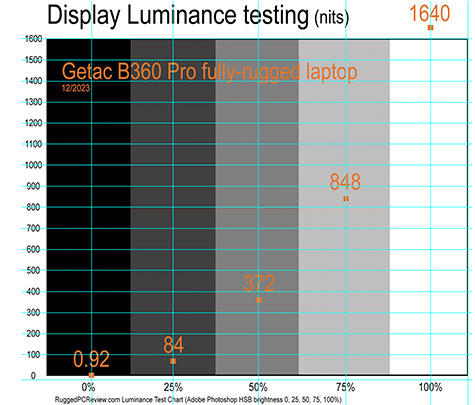 A standard laptop display is generally in the 200-250 nits range, and rarely reaches 300 nits. Premium tablets are in the 400-600 nits range. Some heavy-duty rugged gear went as high as 1500 nits, but that generally required a massive, heavy battery. A standard laptop display is generally in the 200-250 nits range, and rarely reaches 300 nits. Premium tablets are in the 400-600 nits range. Some heavy-duty rugged gear went as high as 1500 nits, but that generally required a massive, heavy battery.
The Getac B360 Pro display is listed as 1400 nits, which is very bright. And its various optical treatments cut down the percentage of incoming ambient light. That's important because the ratio between the backlight and the reflected incoming ambient light determines the effective contrast ratio, which then translates into the degree of real world outdoor readability of a display. And as if 1400 nits weren't bright enough, in our own testing we actually saw a maximum of 1640 nits!
The matrix below shows the B360 Pro display under a wide variety of viewing conditions.
Overall, its sheer brightness precludes the picture from washing out, the way it does on lesser screens, under almost any lighting condition. The semi-matte surface also totally eliminates the sharp reflections that bedevil standard "glossy" displays outdoors.
There are, however, no completely perfectly solutions to outdoor viewability with current display technology. Getac made this display as bright as possible while, with prudent use of full brightness, still offering generous battery life. But even with a semi-matte displays surface, reflections manifest — not in a distracting mirror-like way, but a degree of milkiness when the display diffuses light.
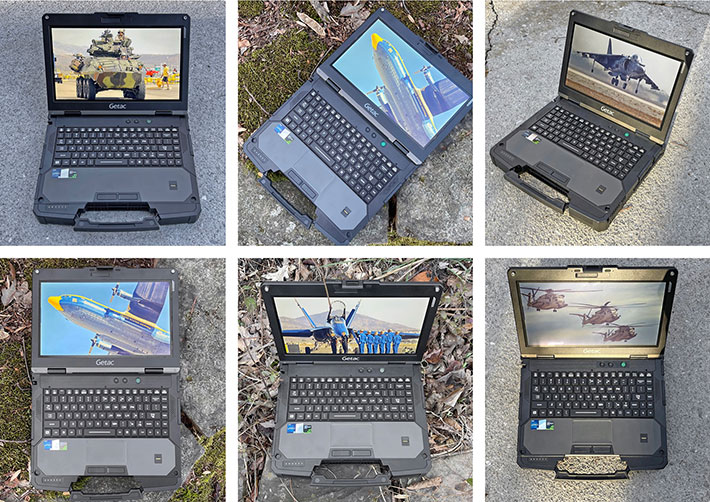
As is, the B360 Pro display is excellent. Both glossy and semi-matte screens have their pros and cons, but outdoors and in the sun, semi-matte's ability to diffuse the sharp reflections of glossy screens can be a distinct advantage. This is about as good as it currently gets.
One thing, though: It's time to increase screen resolution! Advanced laptops such as the Getac B360 Pro are increasingly used for complex imaging tasks and computations, and the by now fairly dated "Full HD" 1920 x 1080 pixel is becoming insufficient. It'd be nice to get 1440p 2560 x 1440 resolution at least as an option.
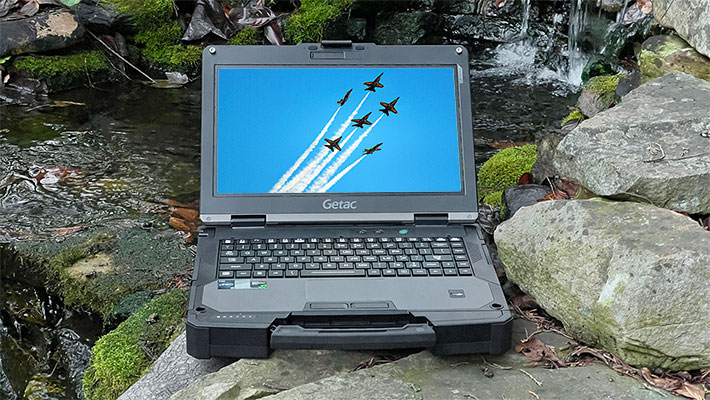
Glove touch and handling rain
One of the limiting issues with capacitive multi-touch is that in its generic form, it only works with human fingers or, to a lesser extent, with capacitive styli. Capacitive touch doesn't like rain and it won't accept thick gloves and such. Unfortunately, wetness and the need for gloves is exactly what one encounters out there where machines such as the Getac B360 Pro are often used.
Getac was one of the first to address these issues, and solutions have been part of the LumiBond® 2.0 technology for several years. There's a special G-Manager "Touch Screen" display where users can select "Finger Mode," "Glove Mode," or "Stylus Mode." Here's how it works:
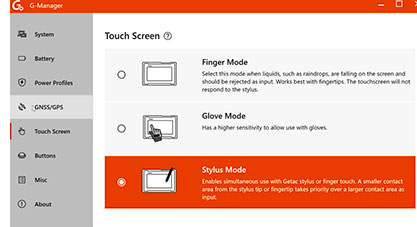 In "Finger Mode," touch continues to work in rain or when other drops are falling onto the display. Water is so conductive that it affects the capacitance between two electrodes, which is the concept upon which projected capacitive touch is built. In "Finger Mode," touch continues to work in rain or when other drops are falling onto the display. Water is so conductive that it affects the capacitance between two electrodes, which is the concept upon which projected capacitive touch is built.
What can be done is switching from a standard mutual capacitance mode to self-capacitance where the capacitance between one electrode and the ground is measured instead of the capacitance between two electrodes. That would preclude a capacitive pen from working in this mode because a fairly large touch area is required. The capacitive pen does work, however, so what Getac probably did is make sure the light touch of a rain drop is not interpreted as a finger touch.
"Glove Mode" allows the B360 Pro to be operated with gloves. That is done by increasing the sensitivity of the touch controller, so that it can recognize a finger even a brief distance away from the screen, as in the distance that the material of a glove adds to the finger's distance from the screen. That's the way Getac seemed to have done it, as not only do gloves work in this mode, but the cursor now follows the finger even when it is a short distance away from the surface, and touch operations no longer require a firm touch.
"Stylus" mode is for use with the dual-mode input option. Finger touch continues to work in stylus mode, but the system will not recognize touch when it sense the pen in use, and vice versa. Stylus mode is also for use with narrow-tip capacitive pens, where the smaller contact area of the stylus takes priority over the large contact of finger touch.
Summary: Getac B360 Pro fully rugged notebook computer
With the next generation of the B360 Pro, Getac leapfrogs its primary competition in the modern, full-size, fully rugged laptop race. What's the difference to the standard Getac B360? In essence, the B360 Pro is a taller and more substantial version of the lighter, thinner standard Getac B360 for customers with emphasis on more connectivity, more features, more expansion and, perhaps most importantly, much more battery capacity.
Fully equipped, the Getac B360 Pro weighs just a eight pounds, three pounds more than the starting weight of the standard version. In terms of technology, the two versions are nearly identical, offers excellent performance from their Intel 12th gen Core processors and super-fast PCIe NVMe storage, with the Pro version offering more storage and optional NVIDIA GTX1650 graphics that boosts performance for graphics-oriented applications.
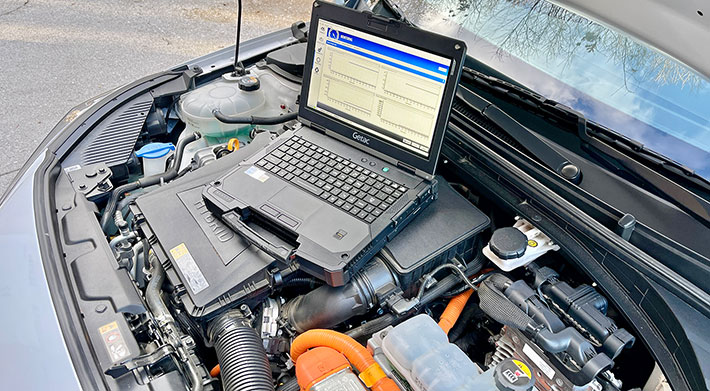
Now add to that a smoothly operating capacitive multi-touch display that's also the brightest available screen in this class (or most others), up to 195.6 watt-hours of hot-swappable battery power, and things you don't usually get in rugged laptops (like an optional integrated scanner or optical drive), and you have a platform that is hard to beat. – Conrad H. Blickenstorfer, February 2024
|
Getac B360 Pro G2 fully-rugged laptop Specs
|
| Status |
Introduced June 2023, full review September 2023 and updated February 2024
|
| Type |
Fully rugged notebook
|
| Processor |
Intel Core i7-1280P (6 P-cores/8 E-cores, 4.8 GHz max turbo)
Intel Core i7-1270P (4 P-cores/8 E-cores, 4.8 GHz max turbo)
Intel Core i5-1260P (4 P-cores/8 E-cores, 4.7 GHz max turbo)
Intel Core i5-1250P (4 P-cores/8 E-cores, 4.4 GHz max turbo)
Intel Core i5-1240P (4 P-cores/8 E-cores, 4.4 GHz max turbo)
|
| Thermal Design Power |
28/64 watts (all available processors)
|
| Graphics |
Intel Iris Xe Graphics, opt. NVIDIA GTX 1650
|
| OS |
Windows 11 Professional (64-bit)
|
| Memory |
8GB DDR4 expandable to 64GB in two SODIMM slots
|
| Storage |
Main storage: 256GB / 512GB / 1TB / 2TB PCIe NVMe SSD
Optional 2nd storage: 256GB / 512GB / 1TB / 2TB NVMe SSD
Optional multimedia bay storage: 1TB or 2TB SATA SSD
|
| Expansion slots |
1 x SD card, 1 x Smart Card
|
| Display type |
IPS TFT LCD, LumiBond® 2.0 sunlight readable LED display
|
| Display size/res |
13.3"/1920 x 1080 pixel (166 ppi) 1400 NITs (measured 1549 NITs)
|
| Digitizer |
10-point capacitive multi-touch |
| Keyboard |
LED backlit membrane keyboard; optional LED backlit rubber keyboard |
| Housing |
Getac ABS+PC and magnesium alloy |
| Size |
13.46" x 11.06" x 2.11" inches (342 x 281 x 54 mm)
|
| Weight |
Starting at 6.8 pounds (3.08 kg); weight as tested: 7.8 lbs with two batteries and optical drive
|
| Operating temperature |
-20° to 145°F (-29° to 63°C) |
| Drop test |
MIL-STD-810H 6-ft drop
|
| Ingress protection |
IP66 |
| Vibration |
e-Mark certified for vehicle usage |
| Humidity |
95% RH, non-condensing
|
| Disinfectants |
See Getac rugged mobile computer decontamination
|
| EMI |
MIL-STD-461G certified
|
| Power |
2 x 10.8V 6,900 mAH 74.5 whr Li-Ion batteries plus opt. 11.1V, 4,200mAH 46.6 whr multimedia bay battery
|
| Cameras |
Front-facing FHD webcam or optional Windows Hello webcam
|
| Scanning |
Optional barcode scanner
|
| Security |
TPM 2.0, cable lock slot, Smart Card reader, opt. HF RFID reader
|
| Interface |
1 x Headphone out/mic-in combo, DC-in Jack, 1 x USB 3.2 Gen2 Type A, 1 x PowerShare USB 3.2 Type A, 1 x Thunderbolt™ 4 Type-C, 1 x LAN (RJ45), 1 x HDMI 2.0, Docking connector.
Configurable I/O Options:
1. 9-pin D-sub serial + 15-pin VGA
2. 9-pin D-sub serial + DisplayPort
3. 9-pin D-sub serial + 15-pin VGA + 2nd RJ45 LAN
4. 9-pin D-sub serial + DisplayPort + 2nd RJ45 LAN
5. 2 x 9-pin D-sub serial + 15-pin VGA
6. 2 x 9-pin D-sub serial + DisplayPort
7. 2 x 9-pin D-sub serial + 15-pin VGA + 2nd RJ45 LAN
8. 2 x 9-pin D-sub serial + DisplayPort + 2nd RJ45 LAN
|
| Wireless |
Intel Wi-Fi 6E AX211, 802.11ax Bluetooth (v5.3); opt. dedicated GPS OR opt. 4G LTE mobile broadband with integrated GPS, opt. 5G Sub-6 with integrated GPS, opt. RF antenna pass-through for GPS, WLAN and WWAN
|
| Price |
Inquire |
| Web page |
Getac B360 Pro web page
|
| Brochure |
 Getac B360 Pro brochure/specs Getac B360 Pro brochure/specs
|
| Warranty |
3-year bumper-to-bumper warranty standard |
|
|
|
|












